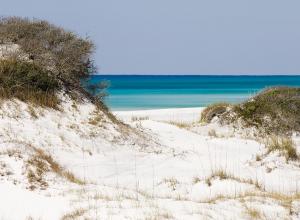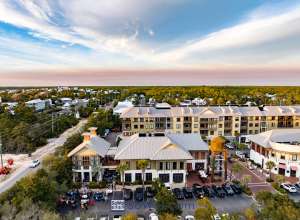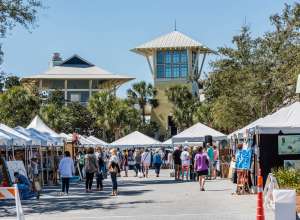Story
A SoWal Summer None Of Us Will Ever Forget
August 5, 2010 by Dwight Williams
What is wrong with this picture? Looking for clues why SoWal was spared…
They were 84 days none of us will ever forget. From April 22 to July 15, an estimated 4.9 million barrels of light, sweet Louisiana crude spewed into the Gulf of Mexico, and it was feared to be only a matter of time before the sugar-white beaches of SoWal became a parking lot.
The news was everywhere and it was beyond bad. It was the apocalypse. Even Jim Cramer, the host the CNBC show “Mad Money,” had an opinion.
On June 24, in what can only be described as an epic screw-up, the affable Wall Street veteran asked his audience: “Do you think anyone is going to want to go on vacation in the Panhandle? Not for years.” He implored his viewers to sell St. Joe stock and ruthlessly mocked stock analysts who were not actively rating the stock a “sell.”
St. Joe, the panhandle’s largest landholder, was trading around $22.50 that day. Today, just six weeks later, it trades near $28. Had you wanted to make a 20% profit in six weeks, all you had to do was ignore Jim Cramer and plunk your money down with St. Joe.
And yet Cramer’s opinion was the conventional wisdom at the time. His opinion, as wrong as it turned out to be, appeared perfectly reasonable. Just a few days ago, on August 2, the federal government came out with figures that officially established the Macondo oil well disaster as “the largest accidental release of oil into water in history.” It eclipsed the 1979 Ixtoc blowout in the Bay of Campeche by 1.5 million barrels.
So why was the actual impact of the oil so light? And where did those millions of barrels of oil go? Let’s break it down:
Of the 4.9 million barrels, government scientists estimate that 800,000 barrels were either burned or collected by skimming vessels. But that still leaves 4.1 million barrels in the water.
The oil that came from the Macondo well is known as Louisiana light sweet crude. As the name implies, it’s light and evaporates quickly when exposed to the atmosphere. In fact, government scientists estimate that up to 60%, or 2.94 million barrels of the total, actually evaporated. This still leaves 1.1 million barrels in the Gulf – still a lot of oil, but less than a quarter of the total.
But there’s a problem with this kind of simple accounting, and it has to do with BP’s use of dispersants. Millions of gallons of the chemical Corexit were applied at the subsurface leak site and aerially. The chemical breaks down oil and turns it into an emulsion and leaves it suspended in the water column. But it’s still there, and the affect on marine life remains unknown. Simply put, much of the oil that would have evaporated on the surface now lingers in the Gulf of Mexico.
What’s undeniable is that the use of dispersants lessened the oil’s shoreline impact on the shoreline at the expense of marine life. Dolphins don’t retain attorneys; property owners do – a fact that BP attorneys surely pointed out to the feckless former BP CEO Tony Hayward.
But this still doesn’t explain why the oil made its way to coastal Louisiana, Mississippi, Alabama and Pensacola – and yet left SoWal relatively unscathed. In June the wind blew for nearly three weeks out of the southwest, leaving us directly downwind of the ruptured well. Oil came ashore for a few days, but the impact was far less severe that initially feared.
To answer this question we contacted Dr. Don Johnson, an oceanographer with the University of Southern Mississippi’s Gulf Coast Research Laboratory. The interview took place last May.
“The coastal Panhandle makes up part of the Mississippi Bight,” he explained. “The bight runs from the eastern Mississippi Delta to Cape San Blas. During the month of May the currents tend to move counterclockwise, east to west. In early June that changes, and the current reverses itself and moves west to east. The prevailing winds shift also from the southeast to the southwest.”
What did this mean for SoWal?
“The longer it takes for them to fix this problem,” Dr. Johnson explained, “the more problems you’re going to have on the Panhandle.”
Right on cue, the winds indeed shifted from the southeast to the southwest in the early days of June, bringing the oil with it. But the winds were generally light, and the oil tended to move parallel to the coastline. For weeks on end it lurked offshore, with only relatively small tongues of oil making landfall. Locals observed that much of it often came in with the tide and left with the tide six hours later.
But as Johnson explained, the oil was kept at bay for the balance of April and all of May due to the prevailing currents and wind. That left only June and half of July (45 days) for it to zigzag with the winds all the way to SoWal – as on July 15 the well was capped. It’s a 220 mile trip in a straight line from the Macondo wellhead to here, and many hundreds of miles more when capriciously propelled by the winds. In short, distance was our friend. So too were the habits of wind and current. Were the dispersants our friend as well? Perhaps a dose of survivor’s guilt is in order.
Now all we can do is hope that the creatures of the Gulf will be so lucky.


















